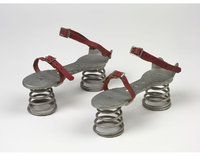Methodology
Summary
In order to frame the geography field as the artwork creation location and not the current location in the application profile, I decided to catalog the collection as artworks and not as images of the artworks. Therefore my Dublin Core Type is set to Physical Objects and utilizes Dublin Core (DC) as the base profile and employed AAT, TGN, LCSH, and Rights Statement controlled vocabularies
---------------------------------------------------------------------------------------------------
Identifier
dcterms:identifier
Since the collection artworks came from a wide variety of institutions with varying identifier formats, I decided to create my own naming standard in order to efficiently identify the source institutions for each work. ‘m’ for moon followed by ‘year’ then the source institution represented by a self-created ‘four string letter code’ and sequential ‘object number’. For example, the identifier/accession number for 17.190.688 from The Metropolitan Museum of Art was reassigned as m_2021_metm_01.
Title
dcterms:title
Title of the artwork is cited directly from the source institution website.
Alternative Title
dcterms:alternative
Added an optional field to maintain alternative titles for artwork that has an alternative or subtitle from the source institution.
Description
dcterms:description
The descriptions were modified for brevity based on the source institution website.
Creator
dcterms:creator
Creator names were cited directly from the source institution website including dates. For artworks with unknown creators I followed the CCO guidelines model, unknown-plus-culture.
Date
dcterms:date
Date maintained from source. Fields that expressed a possible creation date range were standardized from 1960s-1970s to ca.1960-1970 in order to maintain consistency across the 10 records.
Medium
dcterms:medium
The medium field from most of my source metadata seemed to be a combination of medium and classification, depending on the originating institution’s metadata application profile. I decided to crosswalk the source metadata into two fields, medium and format. Medium being the “materials or physical carrier of the object” and Format the “physical medium or dimension”, which was modified to display as Work Type. For example, the Virgin of the Apocalypse’s source institution medium description was “Ivory Sculpture.” This crosswalked to Medium: “ivory" and Work Type: “sculpture (visual works)”.
Work Type
dcterms:format
As mentioned in the medium field I decided to split my source metadata for medium into Medium and Work Type, which is encoded in the DC Format field. I utilized Work Type based on CCO guidelines that state a Work Type “reflects the form of the work,” because I wanted to clearly represent the diverse forms of artworks tied together under the theme of the moon. To emphasize this even more I assigned the Getty Art & Architecture Thesaurus (AAT).
Geography (Originated)
dcterms:spatial
I decided to catalog the physical object because I wanted to list the geography of origin for my item set, not the physical location of the artworks. Following DC guidelines for the Coverage field, “because coverage is so broadly defined, it is preferable to use the more specific subproperties Temporal Coverage and Spatial Coverage.” I decided to encode using spatial but relabel it Geography (Originated), which aligns with the majority of my source institution field labels. For most of the artworks, I retained the source geography values and cataloged them using the Getty Thesaurus of Geographical Names (TGN). For works that expressed uncertainty I kept the source values.
There was one instance where the source geography metadata for item m_2021_lacm_01, from LACMA listed the geography from country, state, region, to districts (India, Rajasthan, Mewar, Udaipur). I searched each one in the TGN vocabulary and decided to avoid double-indexing and select the most granular geography “Udaipur” which is linked to Rajasthan, India in TGN.
Subject
dcterms:subject
Subject terms focused topically and were added based on what was indexed in Getty: The Art & Architecture Thesaurus (AAT) and the Library of Congress Subject Headings (LCSH).
Rights
dcterms:Rights
I employed Right Statement.org for this field to designate if an artwork is or is not in copyright.
Rights Holder
dcterms:rightsHolder
I added the Rights Holder field to provide additional confirmation if an artwork was in the Public Domain or to designate the institution or individual who holds the rights to the artwork.
Source Institution
dcterms:source
Though Source in DC is a “reference to a resource from which the presented resource is derived.” I’m treating the museums as the reference resource and therefore the Source Institution. I included the name of the museum as my field value and treated the URI as the permalink to the item record.
